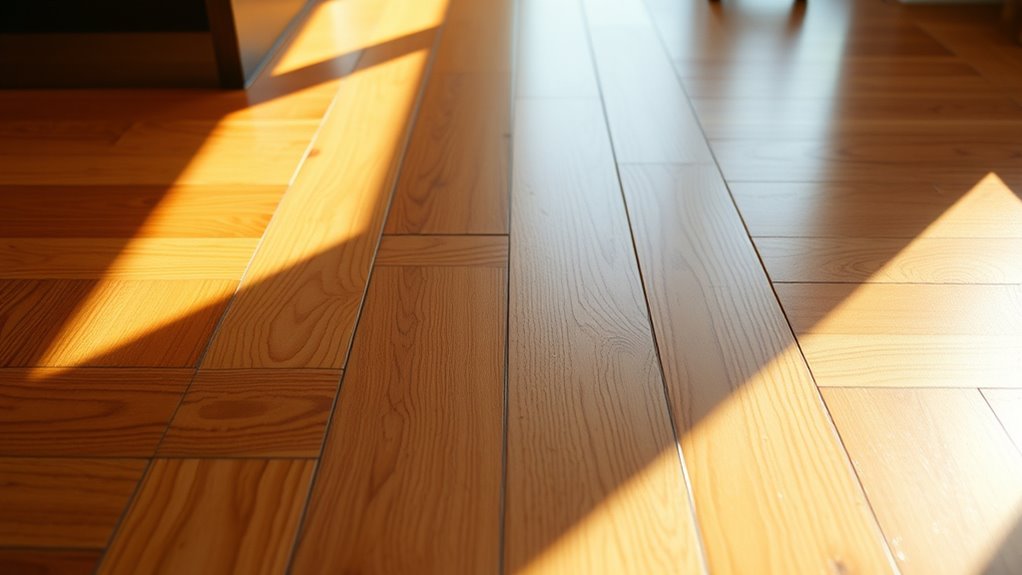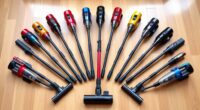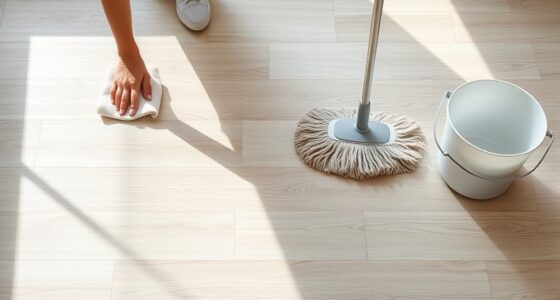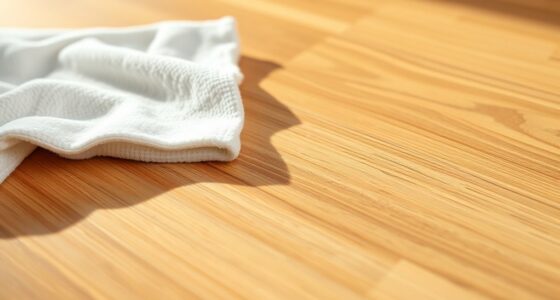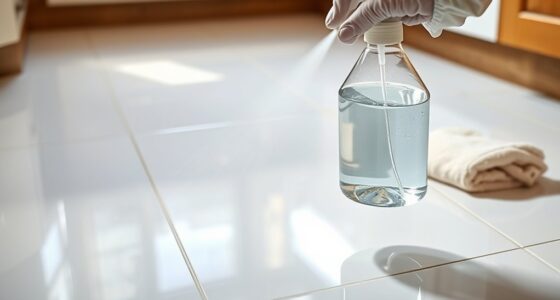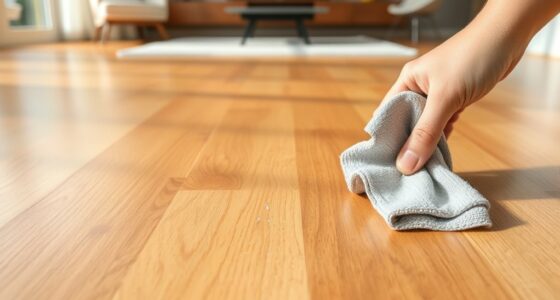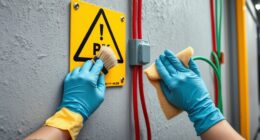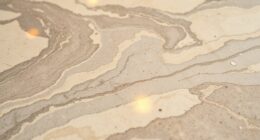For sealed hardwood floors, dry mopping is best for daily maintenance to remove dust and loose dirt without risking water damage. Use a microfiber dust mop or soft broom and avoid liquids. Damp mopping, done weekly or for deeper cleaning, requires a barely moist microfiber mop with a gentle cleaner to pick up stubborn stains while protecting the finish. Knowing when and how to use each method helps keep your floors beautiful—discover more tips below.
Key Takeaways
- Dry mopping is ideal for daily maintenance and quick removal of dust and pet hair on sealed hardwood floors.
- Damp mopping provides deeper cleaning but should be done with a barely moist microfiber mop to prevent water damage.
- Excess water during mopping can seep into seams, causing warping and damage to the sealed surface.
- Use dry mops for regular upkeep and switch to damp mopping weekly or in higher traffic areas.
- Proper technique—wringing out the mop and avoiding soaking—protects the finish and prolongs the floor’s lifespan.
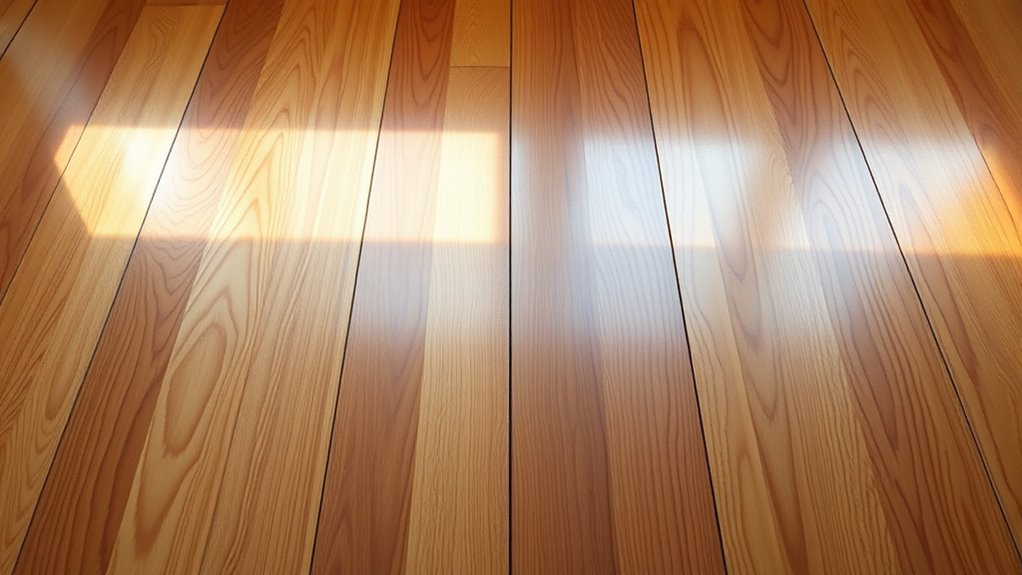
When it comes to cleaning sealed hardwood floors, choosing the right mopping method can make a big difference in their appearance and longevity. One of the most significant decisions you’ll make is how often to clean and which mop type suits your needs best. Your cleaning frequency depends on your household activity—if you have pets, kids, or high foot traffic, you’ll need to clean more often to prevent dirt buildup. Typically, a good rule of thumb is to sweep or dry mop daily or every few days to remove loose debris and prevent scratches. For deeper cleaning, weekly damp mopping is recommended to lift grime without damaging the finish. Incorporating proper cleaning techniques can also help prolong the life of your floors and maintain their natural beauty.
The type of mop you use plays an essential role in maintaining your sealed hardwood floors. A microfiber flat mop is often the best choice because it’s gentle yet effective at trapping dust and dirt. Its flat design allows you to cover large areas quickly and evenly. When using a damp mop, it’s essential to avoid excess water, as too much moisture can seep into the seams and damage the wood over time. Always wring out your mop thoroughly before use, ensuring it’s just damp—not soaking wet. This approach reduces the risk of warping and keeps the finish intact.
Dry mopping is excellent for regular maintenance, especially in between deeper cleanings. It quickly picks up dust, pet hair, and loose dirt, preventing scratches and dullness. If you prefer a dry mop, a microfiber dust mop or a soft broom works well. These tools are lightweight, easy to maneuver, and won’t harm the surface. Damp mopping, on the other hand, is best for removing sticky spots, spills, or stubborn dirt that dry dusting can’t handle. When damp mopping, use a gentle cleaning solution designed for hardwood floors, or simply mix a few drops of dish soap with water. Always follow with a clean, damp cloth to remove any residue, then dry the floor with a clean towel or a dry mop to prevent water spots.
Maintaining the proper cleaning routine is also crucial in preserving the finish and overall integrity of your hardwood flooring.
Frequently Asked Questions
How Often Should I Dry Mop Sealed Hardwood Floors?
You should dry mop your sealed hardwood floors at least once a week to keep dust and debris under control. For better maintenance, increase mopping frequency if you notice more dirt or after heavy traffic. Regular dry mopping helps prevent scratches and keeps your floors looking their best. Remember, routine maintenance tips like avoiding excess water and gentle cleaning will prolong the beauty and durability of your hardwood floors.
Can I Use Vinegar to Damp Mop Sealed Hardwood?
Think of vinegar cleaning as a gentle whisper to your hardwood, offering a natural way to refresh its shine. Yes, you can damp mop sealed hardwood with vinegar for routine maintenance, but keep it light—a little goes a long way. Use a well-wrung cloth and avoid excess moisture. This method helps keep your floors looking beautiful while preserving their finish, making vinegar a trusted ally in hardwood maintenance.
Is Steam Cleaning Safe for Sealed Hardwood Floors?
Steam cleaning can be safe for sealed hardwood floors if you use it correctly, but you should be cautious. Excessive heat and moisture may affect hardwood durability over time, causing warping or damage. Always verify your steam cleaner has a low-pressure setting and use it briefly. Test a small, inconspicuous area first. When done properly, steam cleaning can effectively remove grime without compromising your floors’ integrity.
What Type of Mop Is Best for Sealed Hardwood?
Imagine sweeping away a foggy morning—your best tool is a microfiber mop, gentle yet effective. For sealed hardwood, microfiber or soft cotton mops are ideal because they trap dust without scratching. Use a damp mop for regular cleaning, about once a week or as needed, and avoid excessive moisture. These mop materials and cleaning frequency keep your floors gleaming and well-protected over time.
How Do I Remove Stubborn Stains From Sealed Hardwood?
To remove stubborn stains from sealed hardwood, start by mopping frequently with a damp mop using a gentle cleaner. For tough spots, apply a mixture of baking soda and water directly on the stain, then scrub softly with a soft cloth or brush. Avoid excessive moisture and harsh chemicals. Regular mopping and proper stain removal techniques help maintain your floor’s appearance and prevent future stubborn spots.
Conclusion
Choosing between a dry or damp mop depends on your hardwood’s condition and your cleaning needs. While a dry mop picks up dust and debris effectively, a damp mop can tackle stubborn spots without causing damage. So, next time you’re cleaning your sealed hardwood, ask yourself: isn’t it worth using the right method to keep your floors looking their best? After all, your home deserves the best care, doesn’t it?
